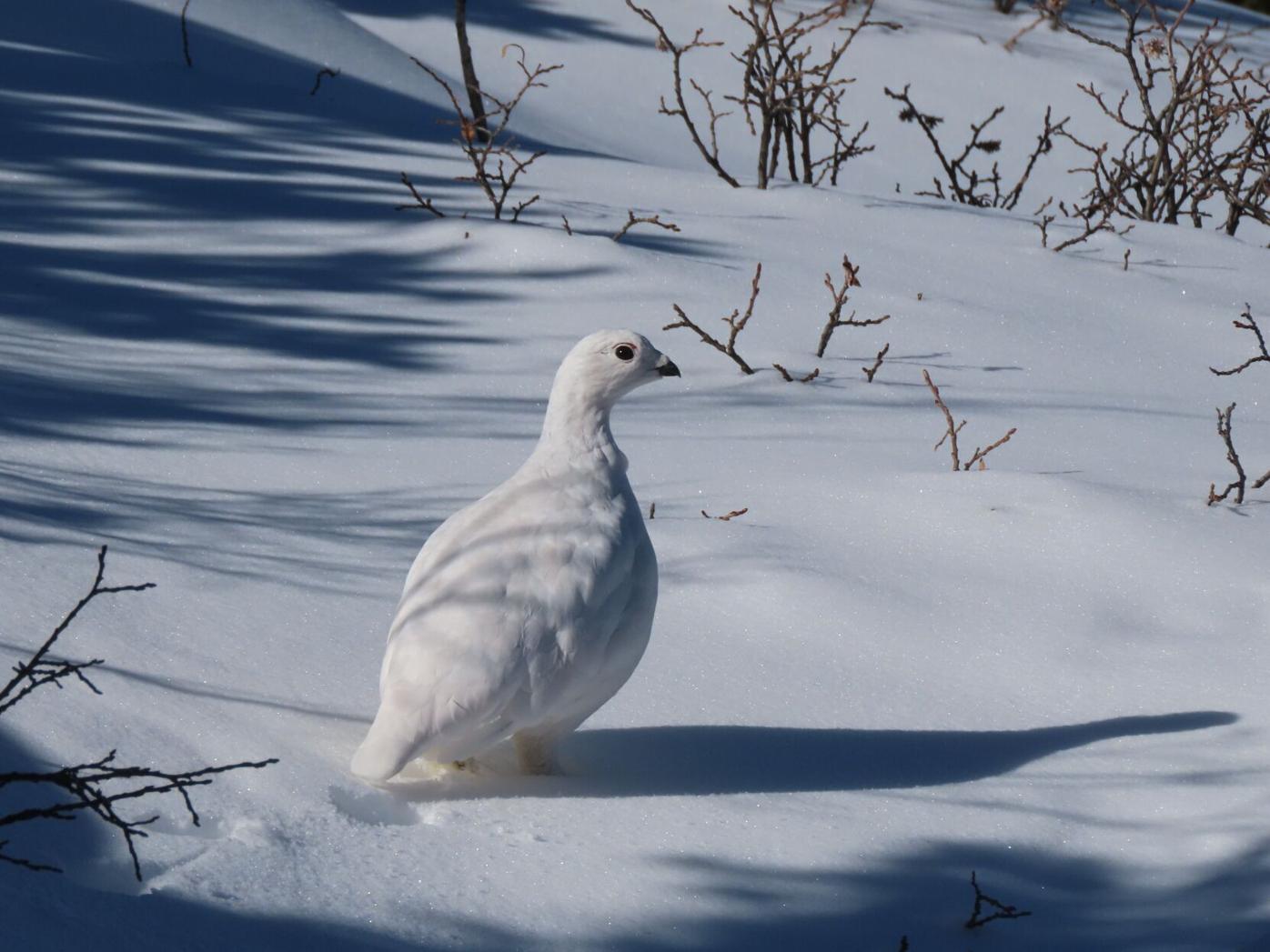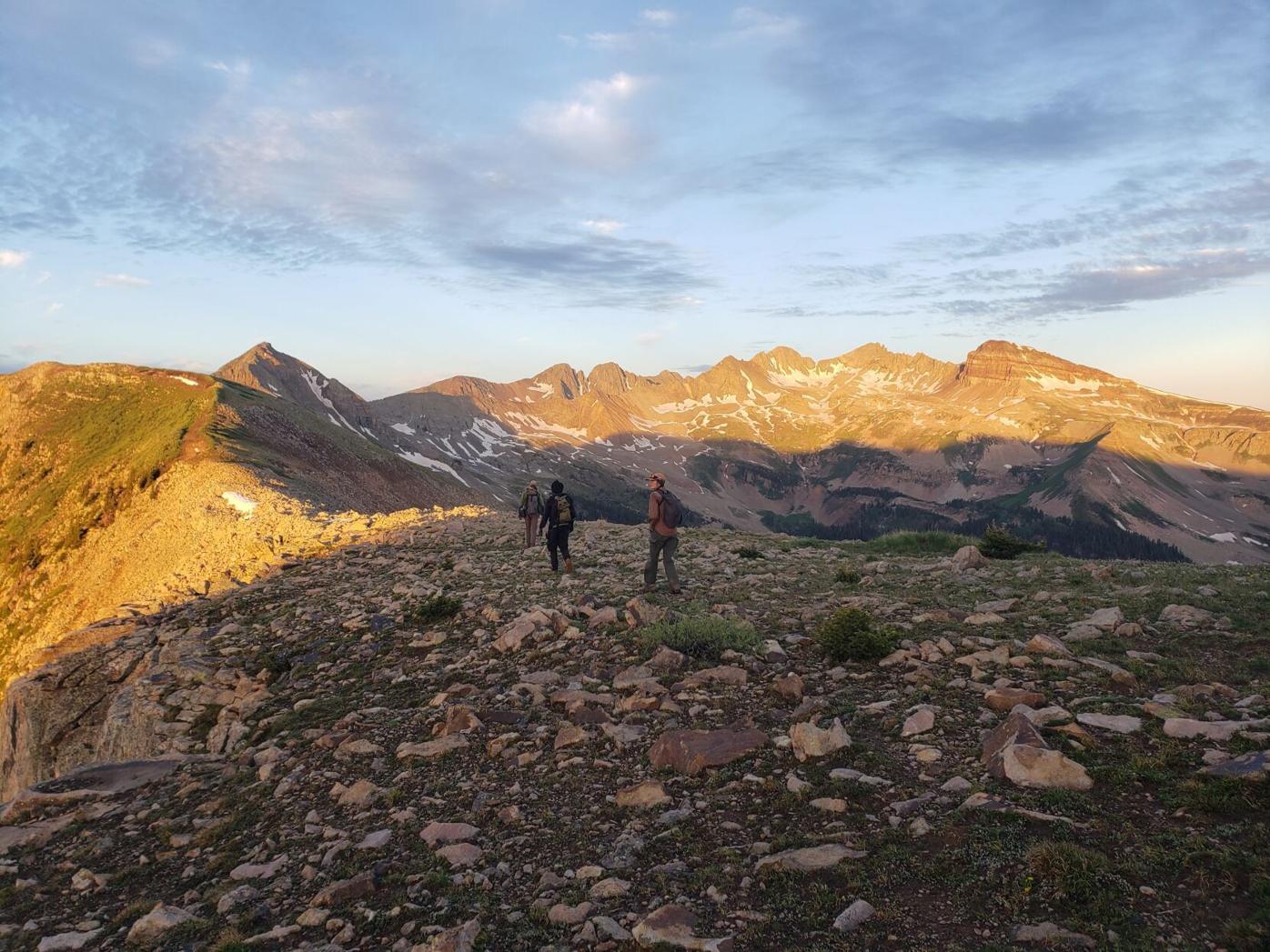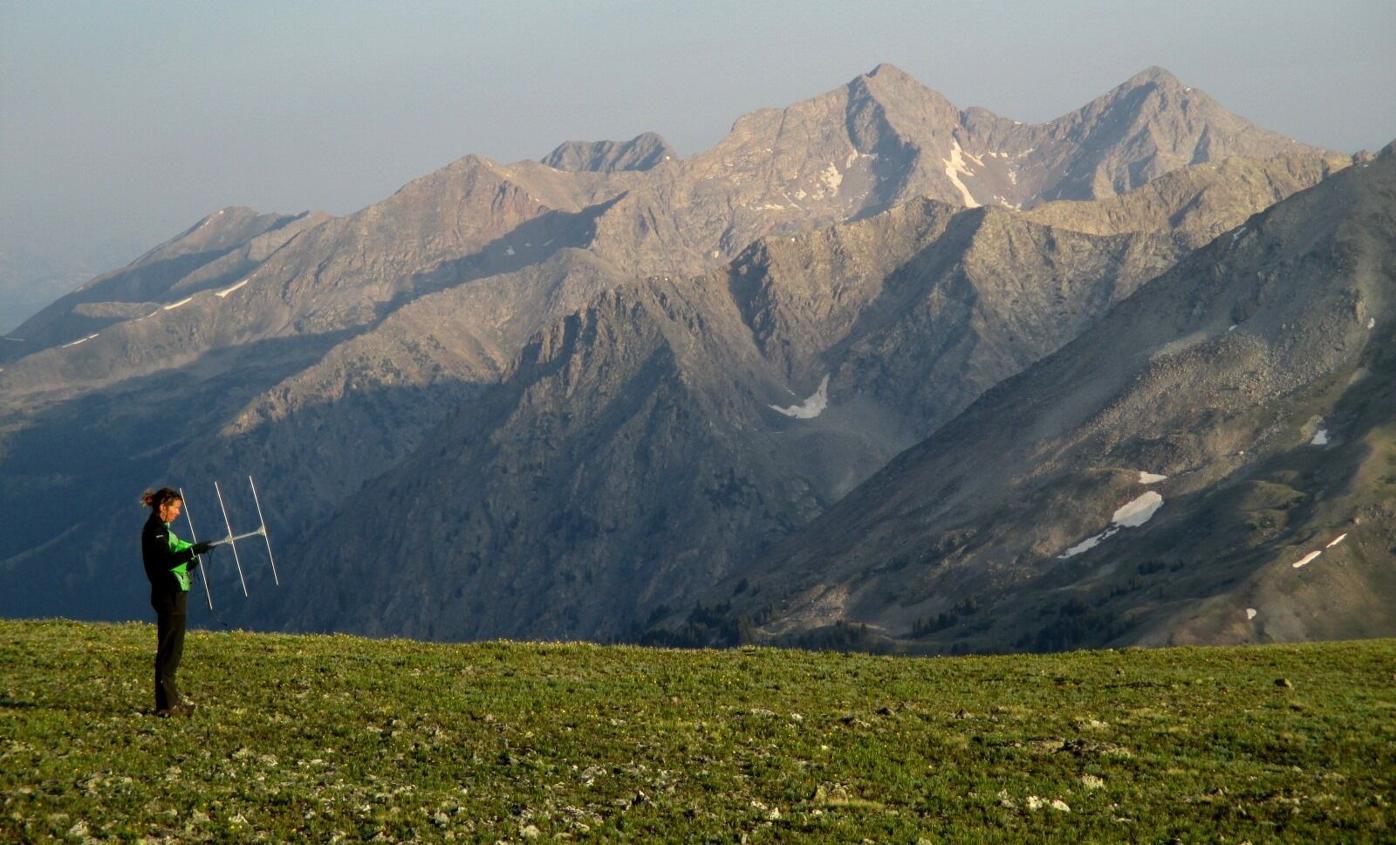The plight of Colorado’s ‘ghost of the alpine’: An uncertain future is ahead for this elusive bird
In the summer of 2006, Amy Seglund recently had moved to Colorado to work as a wildlife biologist when she heard a sound she’ll never forget.
The sun had not yet risen over the San Juan Mountains when Seglund awoke in her tent. It was “a haunting call,” she remembers. It was startling, beautiful.
“It was just one of those times I was just in awe,” Seglund says. “I didn’t know it was a ptarmigan at the time.”
It was a white-tailed ptarmigan. Also at the time, Seglund didn’t know the species would be her career focus.
She knows that call well now — longs for it in her efforts to better understand the species that uniquely makes home in Colorado’s high alpine. Since 2011, Seglund has hiked countless miles in search of the bird hiding in the harsh, rocky, snowy terrain.

A white-tailed ptarmigan casts a shadow on the snow high in Colorado’s mountains.
Photo by Doug Kibbe

A white-tailed ptarmigan casts a shadow on the snow high in Colorado’s mountains.
The awe remains.
“When you find them, it’s magical,” Seglund says.
That’s the word, says Ryan Dibala, an adventurous birder and guide based in Arvada.
“I love how the bird can just sort of appear. … It’s like some sort of magic happened,” Dibala says. “It’s an absolute gem.”
It’s especially sought around this time of year.
In the summer, the crow-sized white-tailed ptarmigan appears pale brown, matching the craggy tundra. Come winter, the bird turns snow white, blending in with its wintry environs — continuing the camouflage defense against predators like foxes, weasels and golden eagles.

White-tailed ptarmigan tend to be found in groups in Colorado’s alpine. In the winter, their pale brown feathers turn white to match the snow.
Photo by Doug Kibbe

White-tailed ptarmigan tend to be found in groups in Colorado’s alpine. In the winter, their pale brown feathers turn white to match the snow.
A book by the late naturalist Joyce Gellhorn calls them “the ghosts of the alpine tundra.” Reads a remark in the opening pages:
“Some people climb Colorado’s high peaks ‘because they are there.’ Pity these folks! There exists an infinitely better reason to endure windburn, strained muscles, blisters and oxygen deprivation: catching a glimpse of the elusive white-tailed ptarmigan.”

White-tailed ptarmigan research involves hiking several miles in Colorado’s high-alpine tundra, where the bird lives.
Photo by Evan Phillips

White-tailed ptarmigan research involves hiking several miles in Colorado’s high-alpine tundra, where the bird lives.
This has long been the aim of Doug Kibbe. The career wildlife biologist leads snowbound trips into the mountains for Denver Audubon.
Guests “really get excited,” Kibbe says. “They have really only a small expectation of actually seeing one. So it’s quite rewarding to be able to bring people up close and let them see what the birds are like.”
This is another hallmark of the white-tailed ptarmigan: their calm, sedentary nature. Indeed, they very well might stay put when approached, allowing one to admire their thick, snow-white plumage that insulates against the freeze.
One might also note the ring of red around males’ black eyes. Male and female feet are warmed by more feathers, which serve like snowshoes as they move in search of willow buds and other food.

The white-tailed ptarmigan’s summer plumage matches its home on the rocky tundra. The bird turns white in the winter. Photo by Kelli Hatch
Photo by Kelli Hatch

The white-tailed ptarmigan’s summer plumage matches its home on the rocky tundra. The bird turns white in the winter. Photo by Kelli Hatch
Their relative stillness — they seem to prefer walking over flying — is “perhaps as a means to conserve energy in their unforgiving habitat,” reads information posted by Rocky Mountain National Park.
The park’s high alpine is one home to the species, the smallest of all North American grouse. White-tailed ptarmigan are known to nest as well around the San Juan Mountains, Mount Blue Sky and Pikes Peak. Loveland and Guanella passes are preferred among hearty, ambitious birders.
“Most people actually encounter them by accident more than anything else,” Kibbe says. “They’re hiking high in the mountains in the summertime, and they’ll run across a female with a brood.”

A search is on for white-tailed ptarmigan in Colorado’s high-alpine tundra. Photo by Whitney Watson
Photo by Whitney Watson

A search is on for white-tailed ptarmigan in Colorado’s high-alpine tundra. Photo by Whitney Watson
A sight in the winter is even more fortunate. The search is “not pleasant,” Dibala says.
The bitter cold, the fierce wind, the post-holing through the snow, the threat of avalanche — no place for us, he has observed. But perfectly fitting to the white-tailed ptarmigan, it seems.
“It seems like such a punishing lifestyle,” Dibala says. “But they always seem in such peace. They’re just there, enduring.”
He can only hope they endure into the future.
Tracking the ‘ghosts’
Seglund shares that hope as she embarks into the mountains for annual monitoring.
The Colorado Parks and Wildlife species conservation coordinator was called to action in 2011 as fear mounted. In a warming climate, could the cold-adapted bird be endangered or threatened?
Seglund could draw comparisons from past data — observations going back to the 1960s noting white-tailed ptarmigan locations across the mountains. Birds were still found in those locations more than 40 years later, Seglund’s team determined.

Amy Seglund holds a device emitting sounds of white-tailed ptarmigan while researching in Colorado’s mountains.
Photo by Shawn Conner

Amy Seglund holds a device emitting sounds of white-tailed ptarmigan while researching in Colorado’s mountains.
“We said, OK, they’re doing good,” she says. “Now let’s go and get a baseline population estimate for the state and see how the sex ratios look, how the reproductive outputs are, and the nest success and brood success. Does that all look the same as in the past?”
She’s still determining answers. So far, she’s not exactly encouraged.
“Concerning” was the word in a report last year that compared data from 2011 to 2022. Female occupancy had declined, according to the report, and “dramatically” so for chick occupancy and the numbers of chicks per hen.
Historic temperatures were also tracked, and “male occupancy appeared to be unaffected by weather conditions,” the report noted.
Potentially explaining the decline in females, the report described them as “solely responsible for incubating and raising broods, and thus may encounter physiological challenges such as hypothermia, reduced body condition, and dehydration with increases in temperature.” The report added the possibility of “intensified exposure to predation in an attempt to find cooler microclimates for self-maintenance.”
From 2011, male and female counts were about even. The 2021 count was 67 males to 33 females. A year later: 75 to 25.
“Because it’s a monogamous bird species, that can be an early indication that something may not be going as well for the bird as we would hope,” Seglund says.
The declining chick counts are equally troubling. “Reproductive output isn’t super high; maybe five to six eggs in one nest per year,” Seglund says. “What percent would those actually survive to be adults the next year?”
The lower occupancy “may be a result of fewer females nesting during an abnormally hot, dry breeding season and lower nest success for females that did nest,” reads the recent report Seglund co-wrote.
Upon hatching, the chicks need vegetation for eating — vegetation that needs moisture to grow. Could chicks be searching further afield at the risk of predation?
“If we start losing that monsoonal moisture — that’s what cools the landscape, what keeps the vegetation — that’s going to be a problem for ptarmigan,” Seglund says. “And it’s kind of coming true from what I’m seeing.”
She’s no longer seeing birds in certain locations listed as “subpar” habitat a decade ago. The fear is a changing climate that creates more “subpar” swaths across the alpine.
“If we have changes in snow … you could have a white bird on a brown landscape,” Seglund says. “Which, again, makes them susceptible” to predators.
Hope for the future
The birds are responding to seasonal changes, a 2016 study suggested.
Compared with data from the 1960s, researchers found birds in Rocky Mountain National Park and on Mount Blue Sky breeding nine to 12 days earlier in the spring.
“Climate did affect when ptarmigan bred, and warmer spring temperatures have led to ptarmigan nesting earlier than they did” in the ’60s, a researcher at Colorado State University, Greg Wann, said in a school news release at the time. “We don’t know if earlier breeding will be a good or bad thing for ptarmigan in the future.”
Perhaps earlier breeding could allow more time to produce more chicks; two clutches of eggs instead of one, some have theorized. Or perhaps chicks would hatch “mistimed;” they could struggle against lingering snow.
The study found climate change’s overall impact on the population to be similarly uncertain. Over 45 years, the population on Mount Blue Sky remained unchanged, while birds at Rocky Mountain National Park “declined significantly.”
“Fortunately, the ptarmigan populations we studied appear to be handling the warming summers, at least given the warming that has happened so far,” Wann said then in 2016. “As warming in alpine habitats increases and advance snowmelt even further in the coming years, we hope ptarmigan in Colorado will continue to cope with these changing environments.”
That’s the hope of enthusiasts like Dibala.
“You do worry about these guys that are so specialized and have funneled themselves into such a narrow corner of the world, and so they are more vulnerable,” he says.
Knowing their plight, the sight of them is somehow more inspiring to Dibala. “It’s inspiring to think about what they can do and what they can achieve.”
He calls the white-tailed ptarmigan “the ultimate survivor” — maintaining that peaceful presence in the harsh world of the alpine.
Seglund was glad to be in its presence that summer day in 2006. That piercing call broke the golden hour of a new day.
“I can’t imagine our alpine without the ability to hear that call,” Seglund says. “It would be a sad, lonely place.”










